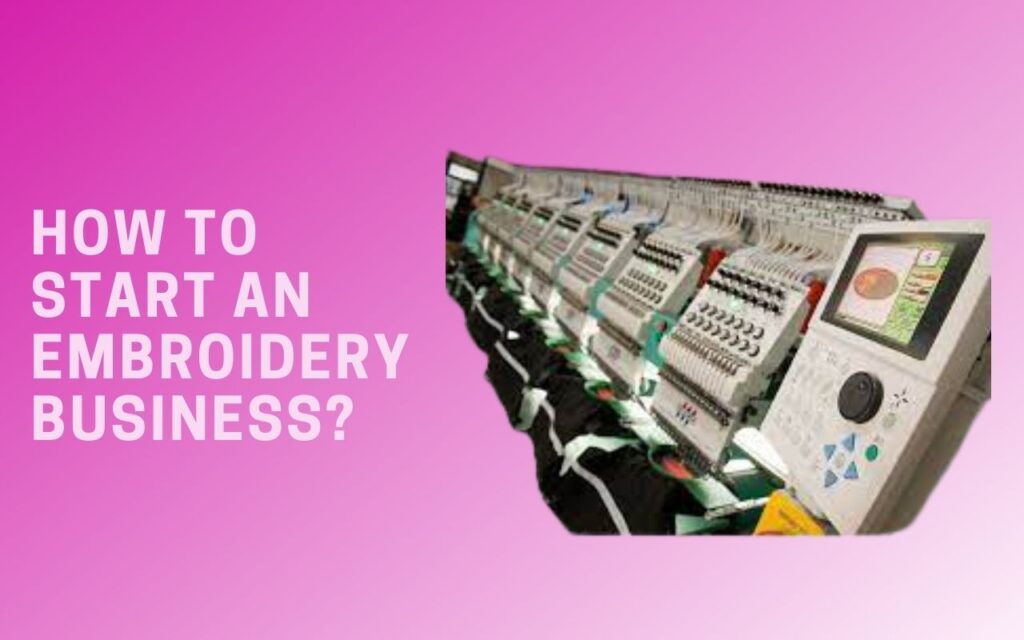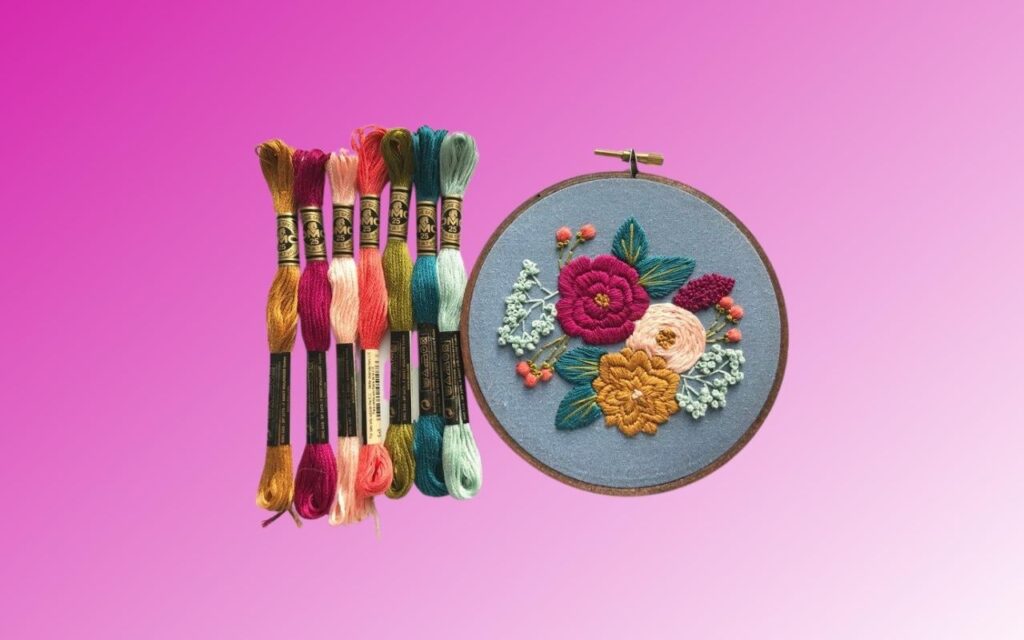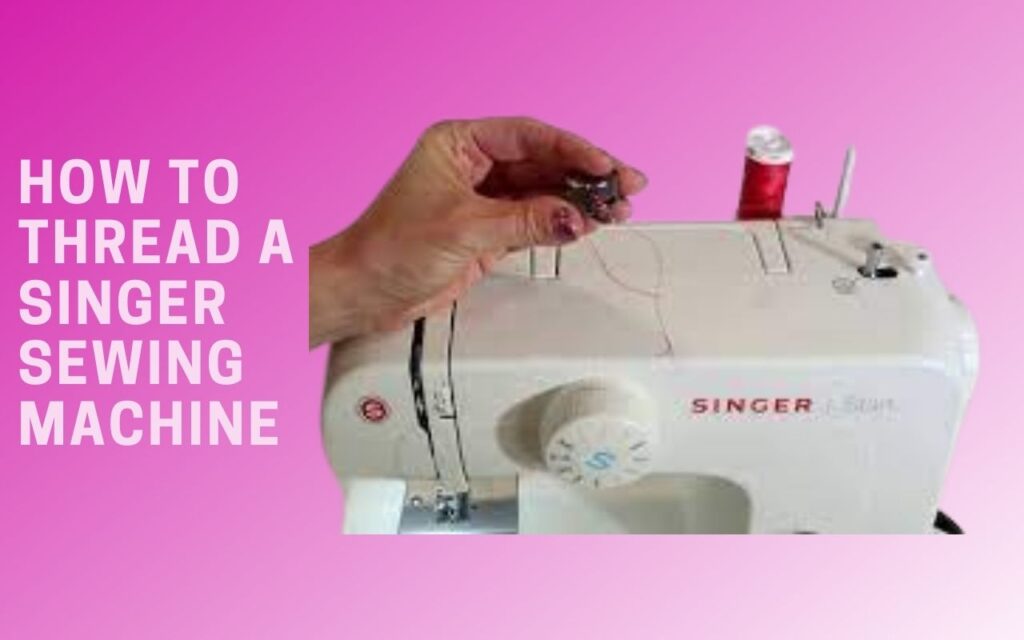Do you love flaunting different outfits of yours daily whether you go to the office or university? Are you a big fan of styling and are always looking forward to coming up with new designs every season? Well, what if we tell you that a sewing machine will not only help you flaunt different outfits, but it will also allow you to design everything according to your own taste and preferences. A sewing machine is no less than a lifesaver for a fashion lover or a designer as it allows them to bring all the materials together while they create something extraordinary.
Furthermore, a sewing machine will allow you to explore your style and help put your ideas into a result. There are many people out there who don’t know how to use a sewing machine as they think that it is difficult to use it. If you want to learn all the basics about a sewing machine, such as the benefits it offers, the types of sewing machines, and how to use it, then make sure you read this guide till the very end.
Contents
- 1 What is the Importance of a Sewing Machine?
- 2 Is Sewing a Good Skill to Have?
- 3 What Are the Benefits of a Sewing Machine?
- 4 1. It helps you sew faster
- 5 2. It can be used for thicker fabrics
- 6 3. It allows you to be creative
- 7 What Are the Types of Sewing Machines?
- 8 Using a Sewing Machine
- 9 Step 1: Set up the sewing machine
- 10 Step 2: Look for the power switch
- 11 Step 3: Understand the buttons and knobs on the machine
- 12 Step 4: Place the fabric on the sewing machine
- 13 Step 5: Press on the foot pedal
- 14 Step 6: Perform the reverse stitch
- 15 Step 7: Remove the needle and presser foot
- 16 Conclusion
- 17 FAQ’s
What is the Importance of a Sewing Machine?
You might be wondering about the importance of a sewing machine or why it is necessary that you learn how to use a sewing machine properly. When it comes to clothing, outfits, and stitching, a sewing machine helps you make something useful like dresses, tote bags, and even scarves. Also, with the help of a sewing machine, you will be able to neatly sew heavy-duty fabric like denim or leather.
Both of these fabrics require extra care while stitching as they are thicker compared to other fabrics like lawn or cotton. A sewing machine can also come in handy for sewing businesses and tailors as the accuracy and neatness of the stitches matter the most.
Is Sewing a Good Skill to Have?
Knowing how to use a sewing machine is a great skill that you can master as it allows you to be productive and efficient with your work. If you learn how to sew and operate a sewing machine, you will be able to alter your clothes and also stitch small things for yourself. These days sewing is a great and profitable skill that is being marketed by everyone.
If you learn how to sew properly, you can even start a fashion line of your own or stitch clothes for other people. When you learn how to sew, the opportunities can be endless for you in the long run. Sewing can also be mastered with time and practice, so if you are confident about obtaining this skill, you should just go for it.
What Are the Benefits of a Sewing Machine?
1. It helps you sew faster
Did you know that before sewing machines were invented, people used to sew clothes by hand, and it would take them hours to complete their work? Ever since sewing machines have been invented, they have made many lives easier. When you have a sewing machine at your disposal, it will greatly improve your performance while stitching and help you sew faster and accurately. Also, with a sewing machine, you will get to save your time and energy and won’t have to spend hours working on an outfit.
2. It can be used for thicker fabrics
Did you know that it can be complicated to stitch certain fabrics as they are thicker or they require detailed stitching? When you learn how to use a sewing machine, you will experience ease when stitching different fabrics such as woolen coats and shawls. Keep in mind that if you stitch these fabrics by hand instead of a sewing machine, then your stitching will lack neatness, accuracy, and correctness. A sewing machine will ensure that the thick fabric has been stitched properly and you get the desired accuracy that you always wanted.
3. It allows you to be creative
If you are into creative styles and designs and love to add motifs and ribbons to your work, then a sewing machine will become your best friend. Many people think that a sewing machine only helps with stitching clothes although it offers you much more than that. When stitching clothes using a sewing machine, you can bring out your inner creativity and add fancy and decorative stuff to your clothes. For example, you can sew a ribbon on your dress or stitch pretty puffed-up sleeves.
What Are the Types of Sewing Machines?
Different types of sewing machines include:
- Mechanical Sewing Machine
- Electronic Sewing Machine
- Computerized or Automated Sewing Machine
- Embroidery Sewing Machine
- Overlock Sewing Machine
Using a Sewing Machine
Now that we have been through the basics and some of the details of a sewing machine, let us take you through a step-by-step process of how to use a sewing machine. This step-by-step process will prove to be an effective guide, so even if it is your first time using a sewing machine, you will be able to understand everything.
Step 1: Set up the sewing machine
Before you start using the sewing machine, you should know how to step it up so that it works properly. You will have to thread your sewing machine by pulling the thread through the needle,

and then you will have to place the bobbin correctly as well.

You can always follow the user manual for the sewing machine as every machine differs slightly from each other. Once you have placed the bobbin, you will have to connect the two threads so that you can prepare for the stitching process.

Position your needle properly by using the knobs so that you can place the fabric underneath when you start stitching.
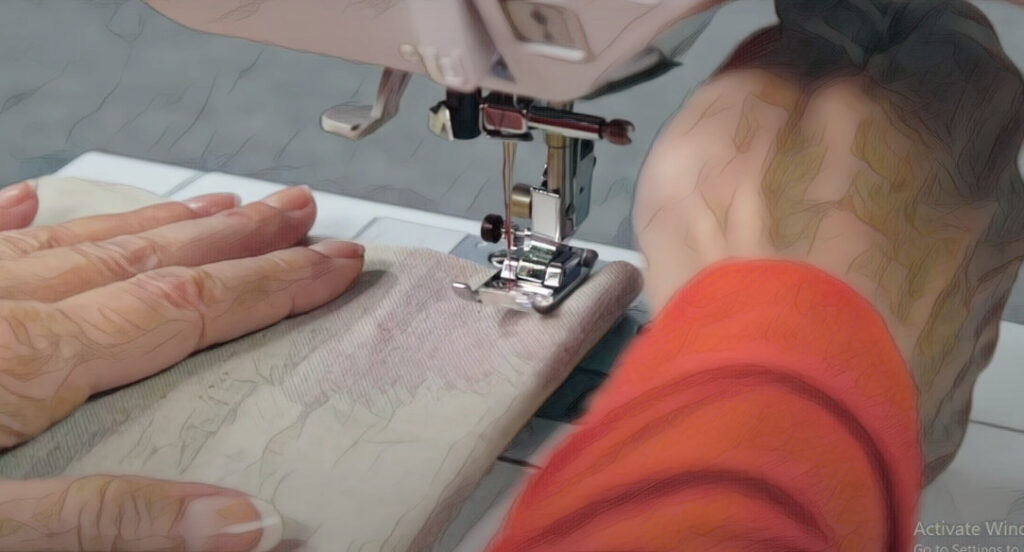
Step 2: Look for the power switch
This might sound like a silly step, but if you are learning how to use a sewing machine for the first time, this can be very helpful. Different sewing machines have their power switch located on different sides, so make sure you check the sewing machine all over. As soon as you find the power switch, connect it to the nearby plug and see if the light on the sewing machine turns on.

The power switch is also connected to the foot pedal, so make sure you place the pedal where your foot can reach comfortably.
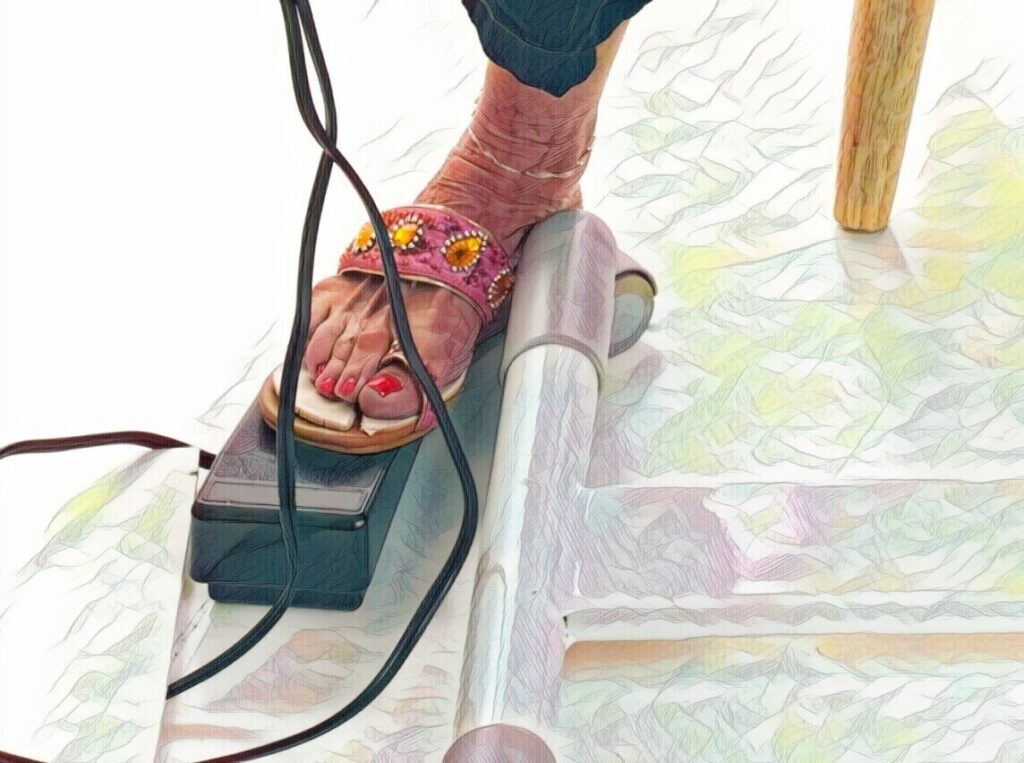
On the front of the machine, you will find out several different buttons and knobs that will be used by you according to the requirement and needs of the task. For example, one of the knobs will help you change the kind of stitch you want, such as doing a straight stitch or a zig-zag stitch. Similarly, you will also find another knob that says if you want tiny stitches, long stitches, or stitches that are close-together. Whatever option that you end up choosing, you will simply have to turn that knob.
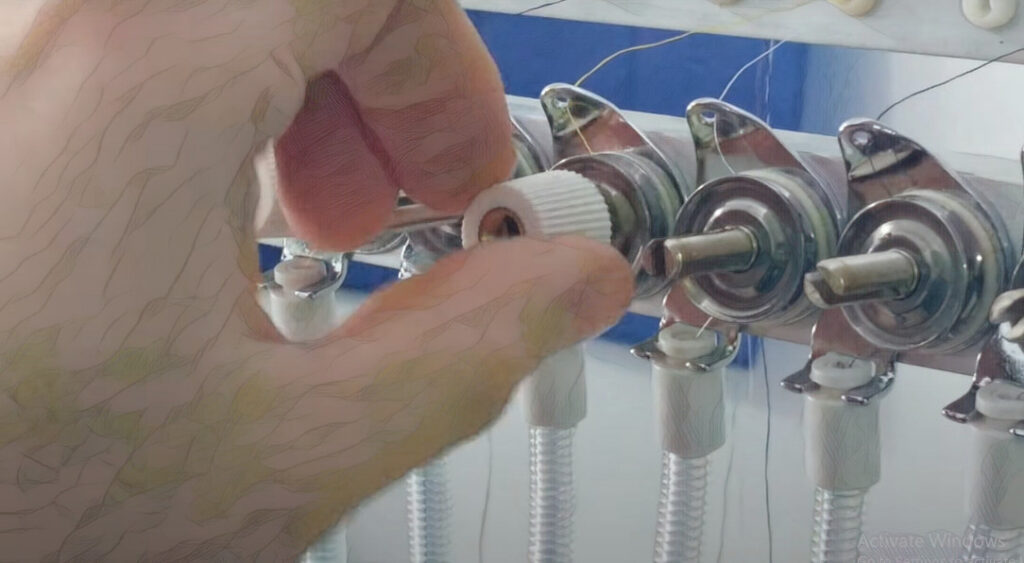
Step 4: Place the fabric on the sewing machine
Once you have set up the sewing machine, turned on the power switch, and understood the buttons and knobs properly,

then the next step is to place the fabric on the sewing machine so you can make the first stitch.

It is natural to be a little afraid at first, which is why you can also use a scrap fabric to test out your stitch. If all goes well, then you can place the original fabric. Make sure that the fabric is placed neatly on the machine and isn’t bunched up because that could cause problems with the stitching quality. After you mark your first line of stitches, lower the presser foot into place as you continue to sew.

Step 5: Press on the foot pedal
When learning how to use a sewing machine, it is crucial that you learn how to press on the foot pedal in a proper manner. Just like a pedal in a car, a foot pedal is like your speed control because the harder you push it, the faster it will go and vice versa. If you are new to the foot pedal, then you can start slowly and then increase your speed as you move on. While you press on the foot pedal, make sure you guide the fabric in a straight line with your hand, or you can ever curve it with your hands when you reach the edges.

Make sure you let the fabric flow is a proper manner and do not force it around because it might cause the needle to break.
Step 6: Perform the reverse stitch

Many sewing machines have a reverse stitch feature that allows you to back up over the stitches that were made previously. If you find the reverse button or lever on your sewing machine, then it will reverse the direction of your stitches. Reversing the stitch is an easy way of making sure that dress doesn’t become ruined due to some loose stitches. Also, with a reverse stitch, you will be able to improve the condition of your dress bows and bag handles and be able to make them stronger. Once you are done stitching the reverse stitch, you can simply cut off the excess threads and then remove the fabric from the machine.

Step 7: Remove the needle and presser foot
After you are done with the stitching and have made the final stitches, then remove the needle and the presser foot slowly.

Slide away your fabric from the machine,
and cut off any excess thread that is left behind on the cloth. Some sewing machines also come with a built-in thread cutter, so if your sewing machine has that, you won’t have to worry at all. Check the fabric and see if everything has been done neatly or if any improvements can be made.
Conclusion
Do you want to unleash your inner fashionista and can’t wait to come up with amazing styles of your own? Are you interested in being capable enough when it comes to stitching and don’t want to depend on anyone else? Learning how to use a sewing machine isn’t only restricted to people who run a stitching business, but people of all ages and genders can learn it. If you are passionate about learning stitching, then you should go for it without the slightest of hesitation.

